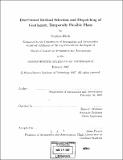| dc.contributor.advisor | Brian C. Williams. | en_US |
| dc.contributor.author | Block, Stephen (Stephen Andrew) | en_US |
| dc.contributor.other | Massachusetts Institute of Technology. Dept. of Aeronautics and Astronautics. | en_US |
| dc.date.accessioned | 2007-08-29T20:39:28Z | |
| dc.date.available | 2007-08-29T20:39:28Z | |
| dc.date.copyright | 2007 | en_US |
| dc.date.issued | 2007 | en_US |
| dc.identifier.uri | http://hdl.handle.net/1721.1/38646 | |
| dc.description | Thesis (S.M.)--Massachusetts Institute of Technology, Dept. of Aeronautics and Astronautics, 2007. | en_US |
| dc.description | Includes bibliographical references (p. 175-178). | en_US |
| dc.description.abstract | Many applications of autonomous agents require groups to work in tight coordination. To be dependable, these groups must plan, carry out and adapt their activities in a way that is robust to failure and to uncertainty. Previous work developed contingent, temporally flexible plans. These plans provide robustness to uncertain activity durations, through flexible timing constraints, and robustness to plan failure, through alternate approaches to achieving a task. Robust execution of contingent, temporally flexible plans consists of two phases. First, in the plan extraction phase, the executive chooses between the functionally redundant methods in the plan to select an execution sequence that satisfies the temporal bounds in the plan. Second, in the plan execution phase, the executive dispatches the plan, using the temporal flexibility to schedule activities dynamically. Previous contingent plan execution systems use a centralized architecture in which a single agent conducts planning for the entire group. This can result in a communication bottleneck at the time when plan activities are passed to the other agents for execution, and state information is returned. Likewise, a computation bottleneck may also occur because a single agent conducts all processing. | en_US |
| dc.description.abstract | (cont.) This thesis introduces a robust, distributed executive for temporally flexible plans, called Distributed-Kirk, or D-Kirk. To execute a plan, D-Kirk first distributes the plan between the participating agents, by creating a hierarchical ad-hoc network and by mapping the plan onto this hierarchy. Second, the plan is reformulated using a distributed, parallel algorithm into a form amenable to fast dispatching. Finally, the plan is dispatched in a distributed fashion. We then extend the D-Kirk distributed executive to handle contingent plans. Contingent plans are encoded as Temporal Plan Networks (TPNs), which use a non-deterministic choice operator to compose temporally flexible plan fragments into a nested hierarchy of contingencies. A temporally consistent plan is extracted from the TPN using a distributed, parallel algorithm that exploits the structure of the TPN. At all stages of D-Kirk, the communication load is spread over all agents, thus eliminating the communication bottleneck. In particular, D-Kirk reduces the peak communication complexity of the plan execution phase by a factor of O (A/e'), where e' is the number of edges per node in the dispatchable plan, determined by the branching factor of the input plan, and A is the number of agents involved in executing the plan. | en_US |
| dc.description.abstract | (cont.) In addition, the distributed algorithms employed by D-Kirk reduce the computational load on each agent and provide opportunities for parallel processing, thus increasing efficiency. In particular, D-Kirk reduces the average computational complexity of plan dispatching from O (N3e) in the centralized case, to typical values of O (N2e) per node and O (N3e/A) per agent in the distributed case, where N is the number of nodes in the plan and e is the number of edges per node in the input plan. Both of the above results were confirmed empirically using a C++ implementation of D-Kirk on a set of parameterized input plans. The D-Kirk implementation was also tested in a realistic application where it was used to control a pair of robotic manipulators involved in a cooperative assembly task. | en_US |
| dc.description.statementofresponsibility | by Stephen Block. | en_US |
| dc.format.extent | 178 p. | en_US |
| dc.language.iso | eng | en_US |
| dc.publisher | Massachusetts Institute of Technology | en_US |
| dc.rights | M.I.T. theses are protected by copyright. They may be viewed from this source for any purpose, but reproduction or distribution in any format is prohibited without written permission. See provided URL for inquiries about permission. | en_US |
| dc.rights.uri | http://dspace.mit.edu/handle/1721.1/7582 | |
| dc.subject | Aeronautics and Astronautics. | en_US |
| dc.title | Distributed method selection and dispatching of contingent, temporally flexible plans | en_US |
| dc.type | Thesis | en_US |
| dc.description.degree | S.M. | en_US |
| dc.contributor.department | Massachusetts Institute of Technology. Department of Aeronautics and Astronautics | |
| dc.identifier.oclc | 163134454 | en_US |
